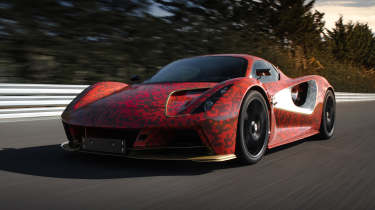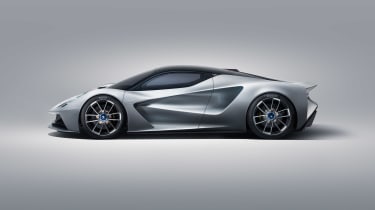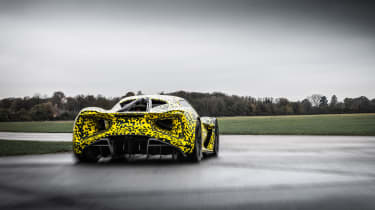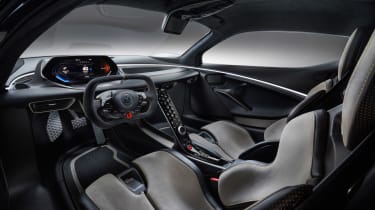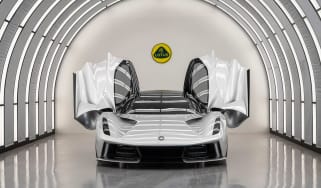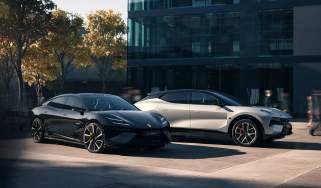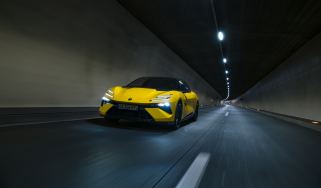Lotus Evija hypercar shown undergoing tests in new film
The global pandemic might have delayed proceedings, but a new video gives us our best look yet at the Lotus Evija hypercar
Late last month, Lotus announced that its all-electric Evija hypercar had been delayed until mid-2021 due to Covid-19-related setbacks. A recent video, however, reveals that the project has regained momentum, with attributes director Gavan Kershaw heading out onto the brand’s Hethel test track.
The first all-new Lotus to be launched under Geely’s stewardship, Evija is a bespoke £1.75m (plus taxes) hypercar that will act as a halo model for a new Lotus range. The upcoming models will eventually lead to replacements for the existing Elise, Evora and Exige, changing the brand’s line-up entirely.
Evija’s aerodynamics explained
The Evija’s styling is typical of a top-tier supercar, with elements borrowed from other historic Lotus models, but reinterpreted for a modern, electric hypercar. The graphics are bold, complex and interesting, but perhaps lacking in the innovation or drama of, say, Aston Martin’s Valkyrie.
However, there’s more to the Evija than mere styling. It goes without saying that a hypercar making twice the power of today’s top-tier performance models will need some particularly special aerodynamic features, and new details from Lotus suggest that will indeed be the case.
Richard Hill, chief aerodynamicist at Lotus, explains that the overall goal has been to use the Evija’s whole shape as a kind of inverted wing, with airflow kept low and flat at the front and emerging higher at the rear. It starts with the carbonfibre chassis, whose sculpted underside is designed to complement the effects of its rear diffuser, while a mixture of aerodynamic sculpting and active elements contribute further.
Hill describes the Evija’s form as ‘porous’, not so much punching its way through the air as using every bit of it that skims across the surface to provide downforce, before it exits through the distinctive rear venturi apertures. That air is also used for cooling, directed by the front splitter over the ‘e-axle’.
Modern hypercars are no stranger to active aero, and the Evija will be the latest to deploy its wings for extra downforce. One element is concealed within the upper bodywork at the rear, raising to increase aerodynamic pressure. A Formula 1-style drag reduction system has also been implemented to mitigate high-speed air resistance, using a horizontal plane mounted centrally at the rear.
Technical details
The Evija’s recipe might not sound like a particularly original idea – the electric hypercar market is filling fast with models planned by Pininfarina, Nio and McLaren – but the technical specifications are still impressive.
Revealed in an onboard video with Gavan Kershaw, British GT racing driver and Lotus’s director of attributes, the model will offer multiple levels of performance depending on the drive mode. Range does exactly what you’d imagine, limiting power to a mere 986bhp and 590lb ft of torque, applying maximum regenerative braking and automatically switching to rear-wheel drive where possible to maximise efficiency. At the other end of the scale is Track, with the full 2000bhp and features such as torque-vectoring and DRS available to the driver.
> Pininfarina Battista Anniversario limited edition revealed
It seems Lotus is well aware of the need for its trademark handling characteristics, even with the arrival of an entirely new powertrain type. 'Lotus has always been about “input = output”, so if you do something you get a response, and that’s what we’re balancing now. It’s also about bringing in experience from other vehicles – what we know from driving Exige and Evora, the Lotus GT race cars – and making sure that core Lotus DNA is all at its absolute best in the Evija,’ said Kershaw.
Performance and powertrain
The Lotus Evija is powered by four electric motors, each with a projected power output of around 500bhp and each connected to an individual wheel, making the Evija the first all-wheel-drive Lotus. The combined output is over 2000bhp, with 1255lb ft of torque available from 0rpm – as with all electric cars.
Feeding these four motors is a battery pack mounted behind the seats, which Lotus says is the most power-dense and advanced of its type. The total battery capacity is rated at 70kWh, and will give the Evija a theoretical range of 250 miles on the WLTP cycle.
Those batteries have also been designed to support up to 800kW charging, a level that would result in a recharge time of the battery pack in as little as eight minutes, if a charger with that capacity were available. As of now, the highest charging capability allowed on the car is 350kW, which will power up the Evija’s batteries to 80 per cent in as little as 12 minutes.
Lotus has announced targeted performance figures too, with the 0-62mph figure of under three seconds expected, while the 0-186mph time is an even more impressive sub-nine seconds.
The Achilles heel of electric hypercars is always excessive weight, but Lotus has revealed an expected figure of around 1680kg in the car’s most focused specification – heavy for a Lotus, but still less than many rivals of similar type.
Chassis and suspension
Underpinning the Evija is a full carbon monocoque chassis, constructed by carbon specialist CPC in Modena, Italy. The one-piece moulding not only houses the cabin and connection points for the front and rear subframes, but will also have part of the underbody aero pack moulded straight into the tub’s underside.
Suspension is by traditional in-board coilovers, while the steering system is an electro-hydraulic unit, an encouraging sign considering it would have been a far easier exercise to fit a more usual EPAS system.
Interior
Inside, the Lotus takes a similar design approach, with the Evija looking every bit the modern hypercar, with a driver-focused and pared-back ambiance offset with plush materials and a delicate use of sculptural carbon. The steering wheel is compact and loaded with controls in much the same way as a Ferrari or Ford GT. Otherwise the only digital interface is in front of the driver, viewable over the top of the small steering wheel for an effect not dissimilar to that provided by Peugeot’s i-Cockpit.
The Evija’s tech even extends to its configurator. It uses the very latest graphics technology to render each customer’s specification in photo-realistic quality. To demonstrate its capabilities, Lotus has so far offered a glimpse of the Evija finished in three new colours: Atomic Red, Solaris Yellow and Carbon Black.
And if this all sounds very futuristic, it’s because it is – a distinct change from the aged, yet still intrinsically pure, model range that Lotus has offered for over ten years now. With 130 units destined for production in Hethel from mid-2021, the Lotus Evija will play the halo product role for the company, but whether it will exhibit the characteristics that have made Lotus’s models so special over its 61-year history remains to be seen.
If this seems like a big ask for a small brand, it’s worth remembering Geely has serious form in transforming historic European brands, such as Volvo, from a niche counterpoint into a major premium player. Let’s hope that momentum continues with one of Britain’s most iconic and often innovative sports.
